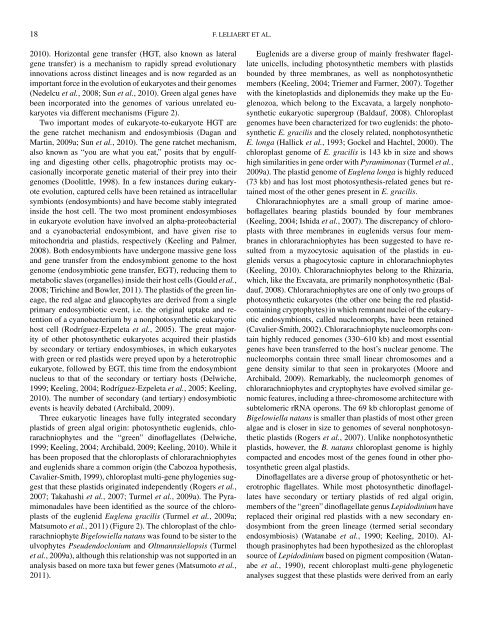Phylogeny and Molecular Evolution of the Green Algae - Phycology ...
Phylogeny and Molecular Evolution of the Green Algae - Phycology ...
Phylogeny and Molecular Evolution of the Green Algae - Phycology ...
- No tags were found...
Create successful ePaper yourself
Turn your PDF publications into a flip-book with our unique Google optimized e-Paper software.
18 F. LELIAERT ET AL.2010). Horizontal gene transfer (HGT, also known as lateralgene transfer) is a mechanism to rapidly spread evolutionaryinnovations across distinct lineages <strong>and</strong> is now regarded as animportant force in <strong>the</strong> evolution <strong>of</strong> eukaryotes <strong>and</strong> <strong>the</strong>ir genomes(Nedelcu et al., 2008; Sun et al., 2010). <strong>Green</strong> algal genes havebeen incorporated into <strong>the</strong> genomes <strong>of</strong> various unrelated eukaryotesvia different mechanisms (Figure 2).Two important modes <strong>of</strong> eukaryote-to-eukaryote HGT are<strong>the</strong> gene ratchet mechanism <strong>and</strong> endosymbiosis (Dagan <strong>and</strong>Martin, 2009a; Sun et al., 2010). The gene ratchet mechanism,also known as “you are what you eat,” posits that by engulfing<strong>and</strong> digesting o<strong>the</strong>r cells, phagotrophic protists may occasionallyincorporate genetic material <strong>of</strong> <strong>the</strong>ir prey into <strong>the</strong>irgenomes (Doolittle, 1998). In a few instances during eukaryoteevolution, captured cells have been retained as intracellularsymbionts (endosymbionts) <strong>and</strong> have become stably integratedinside <strong>the</strong> host cell. The two most prominent endosymbiosesin eukaryote evolution have involved an alpha-proteobacterial<strong>and</strong> a cyanobacterial endosymbiont, <strong>and</strong> have given rise tomitochondria <strong>and</strong> plastids, respectively (Keeling <strong>and</strong> Palmer,2008). Both endosymbionts have undergone massive gene loss<strong>and</strong> gene transfer from <strong>the</strong> endosymbiont genome to <strong>the</strong> hostgenome (endosymbiotic gene transfer, EGT), reducing <strong>the</strong>m tometabolic slaves (organelles) inside <strong>the</strong>ir host cells (Gould et al.,2008; Tirichine <strong>and</strong> Bowler, 2011). The plastids <strong>of</strong> <strong>the</strong> green lineage,<strong>the</strong> red algae <strong>and</strong> glaucophytes are derived from a singleprimary endosymbiotic event, i.e. <strong>the</strong> original uptake <strong>and</strong> retention<strong>of</strong> a cyanobacterium by a nonphotosyn<strong>the</strong>tic eukaryotichost cell (Rodríguez-Ezpeleta et al., 2005). The great majority<strong>of</strong> o<strong>the</strong>r photosyn<strong>the</strong>tic eukaryotes acquired <strong>the</strong>ir plastidsby secondary or tertiary endosymbioses, in which eukaryoteswith green or red plastids were preyed upon by a heterotrophiceukaryote, followed by EGT, this time from <strong>the</strong> endosymbiontnucleus to that <strong>of</strong> <strong>the</strong> secondary or tertiary hosts (Delwiche,1999; Keeling, 2004; Rodríguez-Ezpeleta et al., 2005; Keeling,2010). The number <strong>of</strong> secondary (<strong>and</strong> tertiary) endosymbioticevents is heavily debated (Archibald, 2009).Three eukaryotic lineages have fully integrated secondaryplastids <strong>of</strong> green algal origin: photosyn<strong>the</strong>tic euglenids, chlorarachniophytes<strong>and</strong> <strong>the</strong> “green” din<strong>of</strong>lagellates (Delwiche,1999; Keeling, 2004; Archibald, 2009; Keeling, 2010). While ithas been proposed that <strong>the</strong> chloroplasts <strong>of</strong> chlorarachniophytes<strong>and</strong> euglenids share a common origin (<strong>the</strong> Cabozoa hypo<strong>the</strong>sis,Cavalier-Smith, 1999), chloroplast multi-gene phylogenies suggestthat <strong>the</strong>se plastids originated independently (Rogers et al.,2007; Takahashi et al., 2007; Turmel et al., 2009a). The Pyramimonadaleshave been identified as <strong>the</strong> source <strong>of</strong> <strong>the</strong> chloroplasts<strong>of</strong> <strong>the</strong> euglenid Euglena gracilis (Turmel et al., 2009a;Matsumoto et al., 2011) (Figure 2). The chloroplast <strong>of</strong> <strong>the</strong> chlorarachniophyteBigelowiella natans was found to be sister to <strong>the</strong>ulvophytes Pseudendoclonium <strong>and</strong> Oltmannsiellopsis (Turmelet al., 2009a), although this relationship was not supported in ananalysis based on more taxa but fewer genes (Matsumoto et al.,2011).Euglenids are a diverse group <strong>of</strong> mainly freshwater flagellateunicells, including photosyn<strong>the</strong>tic members with plastidsbounded by three membranes, as well as nonphotosyn<strong>the</strong>ticmembers (Keeling, 2004; Triemer <strong>and</strong> Farmer, 2007). Toge<strong>the</strong>rwith <strong>the</strong> kinetoplastids <strong>and</strong> diplonemids <strong>the</strong>y make up <strong>the</strong> Euglenozoa,which belong to <strong>the</strong> Excavata, a largely nonphotosyn<strong>the</strong>ticeukaryotic supergroup (Baldauf, 2008). Chloroplastgenomes have been characterized for two euglenids: <strong>the</strong> photosyn<strong>the</strong>ticE. gracilis <strong>and</strong> <strong>the</strong> closely related, nonphotosyn<strong>the</strong>ticE. longa (Hallick et al., 1993; Gockel <strong>and</strong> Hachtel, 2000). Thechloroplast genome <strong>of</strong> E. gracilis is 143 kb in size <strong>and</strong> showshigh similarities in gene order with Pyramimonas (Turmel et al.,2009a). The plastid genome <strong>of</strong> Euglena longa is highly reduced(73 kb) <strong>and</strong> has lost most photosyn<strong>the</strong>sis-related genes but retainedmost <strong>of</strong> <strong>the</strong> o<strong>the</strong>r genes present in E. gracilis.Chlorarachniophytes are a small group <strong>of</strong> marine amoeb<strong>of</strong>lagellatesbearing plastids bounded by four membranes(Keeling, 2004; Ishida et al., 2007). The discrepancy <strong>of</strong> chloroplastswith three membranes in euglenids versus four membranesin chlorarachniophytes has been suggested to have resultedfrom a myzocytosic aquisation <strong>of</strong> <strong>the</strong> plastids in euglenidsversus a phagocytosic capture in chlorarachniophytes(Keeling, 2010). Chlorarachniophytes belong to <strong>the</strong> Rhizaria,which, like <strong>the</strong> Excavata, are primarily nonphotosyn<strong>the</strong>tic (Baldauf,2008). Chlorarachniophytes are one <strong>of</strong> only two groups <strong>of</strong>photosyn<strong>the</strong>tic eukaryotes (<strong>the</strong> o<strong>the</strong>r one being <strong>the</strong> red plastidcontainingcryptophytes) in which remnant nuclei <strong>of</strong> <strong>the</strong> eukaryoticendosymbionts, called nucleomorphs, have been retained(Cavalier-Smith, 2002). Chlorarachniophyte nucleomorphs containhighly reduced genomes (330–610 kb) <strong>and</strong> most essentialgenes have been transferred to <strong>the</strong> host’s nuclear genome. Thenucleomorphs contain three small linear chromosomes <strong>and</strong> agene density similar to that seen in prokaryotes (Moore <strong>and</strong>Archibald, 2009). Remarkably, <strong>the</strong> nucleomorph genomes <strong>of</strong>chlorarachniophytes <strong>and</strong> cryptophytes have evolved similar genomicfeatures, including a three-chromosome architecture withsubtelomeric rRNA operons. The 69 kb chloroplast genome <strong>of</strong>Bigelowiella natans is smaller than plastids <strong>of</strong> most o<strong>the</strong>r greenalgae <strong>and</strong> is closer in size to genomes <strong>of</strong> several nonphotosyn<strong>the</strong>ticplastids (Rogers et al., 2007). Unlike nonphotosyn<strong>the</strong>ticplastids, however, <strong>the</strong> B. natans chloroplast genome is highlycompacted <strong>and</strong> encodes most <strong>of</strong> <strong>the</strong> genes found in o<strong>the</strong>r photosyn<strong>the</strong>ticgreen algal plastids.Din<strong>of</strong>lagellates are a diverse group <strong>of</strong> photosyn<strong>the</strong>tic or heterotrophicflagellates. While most photosyn<strong>the</strong>tic din<strong>of</strong>lagellateshave secondary or tertiary plastids <strong>of</strong> red algal origin,members <strong>of</strong> <strong>the</strong> “green” din<strong>of</strong>lagellate genus Lepidodinium havereplaced <strong>the</strong>ir original red plastids with a new secondary endosymbiontfrom <strong>the</strong> green lineage (termed serial secondaryendosymbiosis) (Watanabe et al., 1990; Keeling, 2010). Althoughprasinophytes had been hypo<strong>the</strong>sized as <strong>the</strong> chloroplastsource <strong>of</strong> Lepidodinium based on pigment composition (Watanabeet al., 1990), recent chloroplast multi-gene phylogeneticanalyses suggest that <strong>the</strong>se plastids were derived from an early
















